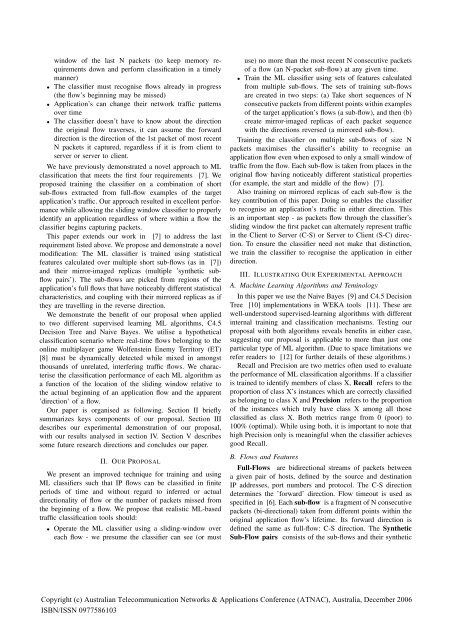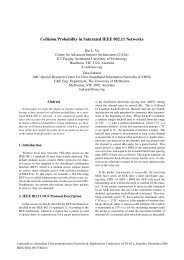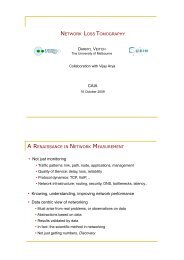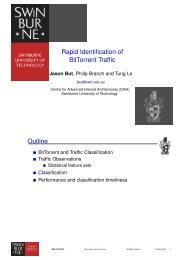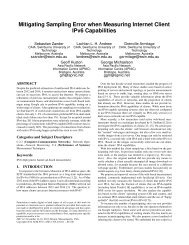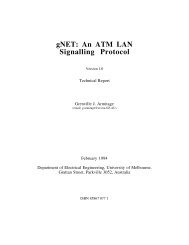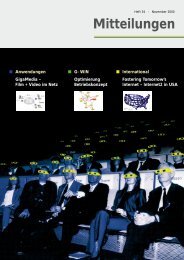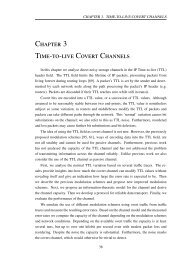Synthetic Sub-flow Pairs for Timely and Stable IP Traffic Identification
Synthetic Sub-flow Pairs for Timely and Stable IP Traffic Identification
Synthetic Sub-flow Pairs for Timely and Stable IP Traffic Identification
You also want an ePaper? Increase the reach of your titles
YUMPU automatically turns print PDFs into web optimized ePapers that Google loves.
window of the last N packets (to keep memory requirements<br />
down <strong>and</strong> per<strong>for</strong>m classification in a timely<br />
manner)<br />
• The classifier must recognise <strong>flow</strong>s already in progress<br />
(the <strong>flow</strong>’s beginning may be missed)<br />
• Application’s can change their network traffic patterns<br />
over time<br />
• The classifier doesn’t have to know about the direction<br />
the original <strong>flow</strong> traverses, it can assume the <strong>for</strong>ward<br />
direction is the direction of the 1st packet of most recent<br />
N packets it captured, regardless if it is from client to<br />
server or server to client.<br />
We have previously demonstrated a novel approach to ML<br />
classification that meets the first four requirements [7]. We<br />
proposed training the classifier on a combination of short<br />
sub-<strong>flow</strong>s extracted from full-<strong>flow</strong> examples of the target<br />
application’s traffic. Our approach resulted in excellent per<strong>for</strong>mance<br />
while allowing the sliding window classifier to properly<br />
identify an application regardless of where within a <strong>flow</strong> the<br />
classifier begins capturing packets.<br />
This paper extends our work in [7] to address the last<br />
requirement listed above. We propose <strong>and</strong> demonstrate a novel<br />
modification: The ML classifier is trained using statistical<br />
features calculated over multiple short sub-<strong>flow</strong>s (as in [7])<br />
<strong>and</strong> their mirror-imaged replicas (multiple ’synthetic sub<strong>flow</strong><br />
pairs’). The sub-<strong>flow</strong>s are picked from regions of the<br />
application’s full <strong>flow</strong>s that have noticeably different statistical<br />
characteristics, <strong>and</strong> coupling with their mirrored replicas as if<br />
they are travelling in the reverse direction.<br />
We demonstrate the benefit of our proposal when applied<br />
to two different supervised learning ML algorithms, C4.5<br />
Decision Tree <strong>and</strong> Naive Bayes. We utilise a hypothetical<br />
classification scenario where real-time <strong>flow</strong>s belonging to the<br />
online multiplayer game Wolfenstein Enemy Territory (ET)<br />
[8] must be dynamically detected while mixed in amongst<br />
thous<strong>and</strong>s of unrelated, interfering traffic <strong>flow</strong>s. We characterise<br />
the classification per<strong>for</strong>mance of each ML algorithm as<br />
a function of the location of the sliding window relative to<br />
the actual beginning of an application <strong>flow</strong> <strong>and</strong> the apparent<br />
’direction’ of a <strong>flow</strong>.<br />
Our paper is organised as following. Section II briefly<br />
summarizes keys components of our proposal. Section III<br />
describes our experimental demonstration of our proposal,<br />
with our results analysed in section IV. Section V describes<br />
some future research directions <strong>and</strong> concludes our paper.<br />
II. OUR PROPOSAL<br />
We present an improved technique <strong>for</strong> training <strong>and</strong> using<br />
ML classifiers such that <strong>IP</strong> <strong>flow</strong>s can be classified in finite<br />
periods of time <strong>and</strong> without regard to inferred or actual<br />
directionality of <strong>flow</strong> or the number of packets missed from<br />
the beginning of a <strong>flow</strong>. We propose that realistic ML-based<br />
traffic classification tools should:<br />
• Operate the ML classifier using a sliding-window over<br />
each <strong>flow</strong> - we presume the classifier can see (or must<br />
use) no more than the most recent N consecutive packets<br />
of a <strong>flow</strong> (an N-packet sub-<strong>flow</strong>) at any given time.<br />
• Train the ML classifier using sets of features calculated<br />
from multiple sub-<strong>flow</strong>s. The sets of training sub-<strong>flow</strong>s<br />
are created in two steps: (a) Take short sequences of N<br />
consecutive packets from different points within examples<br />
of the target application’s <strong>flow</strong>s (a sub-<strong>flow</strong>), <strong>and</strong> then (b)<br />
create mirror-imaged replicas of each packet sequence<br />
with the directions reversed (a mirrored sub-<strong>flow</strong>).<br />
Training the classifier on multiple sub-<strong>flow</strong>s of size N<br />
packets maximises the classifier’s ability to recognise an<br />
application <strong>flow</strong> even when exposed to only a small window of<br />
traffic from the <strong>flow</strong>. Each sub-<strong>flow</strong> is taken from places in the<br />
original <strong>flow</strong> having noticeably different statistical properties<br />
(<strong>for</strong> example, the start <strong>and</strong> middle of the <strong>flow</strong>) [7].<br />
Also training on mirrored replicas of each sub-<strong>flow</strong> is the<br />
key contribution of this paper. Doing so enables the classifier<br />
to recognise an application’s traffic in either direction. This<br />
is an important step - as packets <strong>flow</strong> through the classifier’s<br />
sliding window the first packet can alternately represent traffic<br />
in the Client to Server (C-S) or Server to Client (S-C) direction.<br />
To ensure the classifier need not make that distinction,<br />
we train the classifier to recognise the application in either<br />
direction.<br />
III. ILLUSTRATING OUR EXPERIMENTAL APPROACH<br />
A. Machine Learning Algorithms <strong>and</strong> Teminology<br />
In this paper we use the Naive Bayes [9] <strong>and</strong> C4.5 Decision<br />
Tree [10] implementations in WEKA tools [11]. These are<br />
well-understood supervised-learning algorithms with different<br />
internal training <strong>and</strong> classification mechanisms. Testing our<br />
proposal with both algorithms reveals benefits in either case,<br />
suggesting our proposal is applicable to more than just one<br />
particular type of ML algorithm. (Due to space limitations we<br />
refer readers to [12] <strong>for</strong> further details of these algorithms.)<br />
Recall <strong>and</strong> Precision are two metrics often used to evaluate<br />
the per<strong>for</strong>mance of ML classification algorithms. If a classifier<br />
is trained to identify members of class X, Recall refers to the<br />
proportion of class X’s instances which are correctly classified<br />
as belonging to class X <strong>and</strong> Precision refers to the proportion<br />
of the instances which truly have class X among all those<br />
classified as class X. Both metrics range from 0 (poor) to<br />
100% (optimal). While using both, it is important to note that<br />
high Precision only is meaningful when the classifier achieves<br />
good Recall.<br />
B. Flows <strong>and</strong> Features<br />
Full-Flows are bidirectional streams of packets between<br />
a given pair of hosts, defined by the source <strong>and</strong> destination<br />
<strong>IP</strong> addresses, port numbers <strong>and</strong> protocol. The C-S direction<br />
determines the ’<strong>for</strong>ward’ direction. Flow timeout is used as<br />
specified in [6]. Each sub-<strong>flow</strong> is a fragment of N consecutive<br />
packets (bi-directional) taken from different points within the<br />
original application <strong>flow</strong>’s lifetime. Its <strong>for</strong>ward direction is<br />
defined the same as full-<strong>flow</strong>: C-S direction. The <strong>Synthetic</strong><br />
<strong>Sub</strong>-Flow pairs consists of the sub-<strong>flow</strong>s <strong>and</strong> their synthetic<br />
Copyright (c) Australian Telecommunication Networks & Applications Conference (ATNAC), Australia, December 2006<br />
ISBN/ISSN 0977586103


